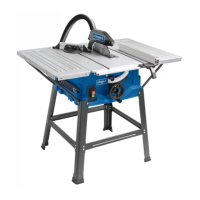www.scheppach.com
32
|
GB
Long and/or wide workpieces tend to tilt at the
edge of the saw table; this leads to a loss of con-
j) Guide the workpiece steadily and evenly. Do
not bend or twist the workpiece. If the saw
blade jams, switch o the electric tool imme-
diately, unplug the mains plug and remedy the
cause of the jam.
the workpiece, this can lead to kickback or block
the motor.
k) Do not remove partially sawn material whilst
the saw is running.
stick between the saw blade and stop rail or in the
and wait until the saw blade has come to a stand-
still, before removing the material.
l) For longitudinal cuts on workpieces that are
thinner than 2 mm, use an additional parallel
stop that is in contact with the table surface.
Thin workpieces can wedge under the parallel
stop and lead to kickback.
Kickback - causes and corresponding safety in-
structions
Kickback is a sudden reaction of the workpiece to a
workpiece at an angle to the saw blade, or if part of the
saw table and thrust in the direction of the operator.
a) Never stand directly in line with the saw blade.
Always stand at the side of the saw blade on
which the stop rail is located. With kickback, the
those persons who stand in front of, or in line with
the saw blade.
b) Never reach over or behind the saw blade to
pull or support the workpiece. This can result in
accidental contact with the saw blade, or kickback
blade.
Safety information for sawing
a) m DANGER: Do not place your hands and
ngers in the sawing area or close to the saw
blade.
A moment of carelessness or a slip could steer
-
b) Only guide the workpiece against the rotation-
al direction of the saw blade or cutting tool.
Guiding the workpiece in the same direction as the
rotational direction of the saw blade above the ta-
drawn into the saw blade.
c) When performing longitudinal cuts, never use
the mitre stop to guide the workpiece, and
when transverse cutting with the mitre stop
never additionally use the parallel stop for lon-
gitudinal adjustment.
the workpiece with the parallel stop and mitre stop
d) When performing longitudinal cuts, always
apply the feed force to the workpiece between
the stop rail and the saw blade. Use a push rod
if the distance between the stop rail and saw
blade is less than 150 mm, and a push block
if the distance is less than 50 mm.
distance from the saw blade.
e) Only use the push rod provided by the manu-
facturer, or a push rod that has been produced
in accordance with instructions. The push rod
and saw blade.
f) Never use a damaged or partially sawn push
rod.
g) Never work “freehand”. Always use the paral-
lel stop or the mitre stop to position and guide
the workpiece. “Freehand” means supporting
or guiding the workpiece with the hands, rath-
er than using the parallel stop or mitre stop.
Free-handed sawing leads to incorrect alignment,
h) Never reach around or over a turning saw
blade. Reaching for a workpiece can lead to acci-
dental contact with the rotating saw blade.
i) Support long and/or wide workpieces at the
rear and/or side of the saw table, so that they
remain horizontal.

